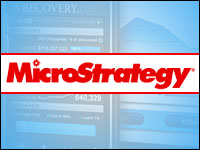
At the beginning of July, MicroStrategy rolled out MicroStrategy Mobile — a platform designed to allow companies to extend their on-premise business intelligence application to the mobile environment.
The following day, VHA, a provider of supply chain management services to reduce healthcare costs, rolled out its own iPhone app built using MicroStrategy Mobile.

This was not a coincidence, said Guillermo Ramas, VP of information and data services for VHA.
“We had been thinking about this for a while and approached MicroStrategy about it,” he told CRM Buyer. “When we learned they were working on a mobile platform, we asked to be part of the process — and to be able to release our own app the day after they released theirs.”
MicroStrategy agreed, and the debuts provide an interesting case study of not only how MicroStrategy believes business intelligence should be deployed in the mobile environment, but also how other companies can take this platform and tailor it to their own industry.
Wherever and Whenever
MicroStrategy began working on a mobile app because it recognized that business intelligence was the type of feature that would perform well in a mobile environment — perhaps even better than on a desktop, Kevin Spurway, VP of product strategy, told CRM Buyer.
“Historically, the device platform hasn’t been mature enough to realize that vision — but then that changed with the introduction of the iPhone and the iPad,” he noted. “What we did was develop the infrastructure to build native apps on these Apple devices and the BlackBerry to take advantage of their features — multitouch and GPS, for example — and leverage those to make for better BI-driven data.”
To illustrate, Spurway pointed to the ability of users to layer analysis on top of a Google map.
MicroStrategy Mobile delivers graphs, grids, enterprise reports and information dashboards to users. The applications are assembled in a point-and-click fashion and do not require any coding, which means that users of a competing BI application can also deploy MicroStrategy Mobile.
All that is required in this scenario, Spurway said, is MicroStrategy on the back end. “There is a lot you can leverage just from that investment, and the mobile app can layer on top of that quickly.”
However, the deployment and subsequent use of the app is easier and more robust if MicroStrategy is used throughout the entire stack, he said.
Selling to Hospitals
VHA used MicroStrategy Mobile to push its pricing application, PriceLYNX, to the mobile environment. It rolled out its iPhone app, PriceLYNX, the day after MicroStrategy released its platform; it recently made the same app available for the iPad, Ramas said.

PriceLYNX was crying out to be deployed on the iPhone and iPad, he said — “especially the iPad, which is better suited to displaying our graphics and data.”
Briefly, PriceLYNX provides detailed information on healthcare supplies purchased by hospitals. There are other applications that provide this information, but Ramos said PriceLYNX differentiates itself by making it far more granular and putting it into context within larger spend categories.
For instance, a price app might be able to tell a hospital administrator that a hospital of its size can expect to spend US$20 for a pair of surgical gloves, with aggressive pricing of $17, he said.
“PriceLYNX will tell you the market will support pricing of $16 all the way to $28 for those gloves — and then give you the price curve of distribution, such as that 10 percent of the best performers are paying less than $25, half of hospitals are paying less than $20, and so on. We can also tell you how your particular hospital is performing in spend on this category.”
A few years ago, the company began receiving user requests from unusual sources, namely physicians, Ramas said. “We realized that this tool was being used for different decisions than we had expected.”
It opted for a mobile app and approached MicroStrategy just at the right time — at the beginning of the year when it was planning its own mobile assault.
Standout Features
MicroStrategy Mobile features that VHA has leveraged include the following:
- out-of-the-box integration with Google maps for visualization of geospatial data and location identification;
- multitouch functions such as the new Apple gestures — swipe, tap, flick and rotate — as well as BI-specific specialized data gestures such as drilling and paging, which extend native iPhone functionality to enhance data exploration;
- integration with other on-device apps including email, browser and text messaging; with third-party apps such as social networks or payment solutions; and with existing enterprise systems or data sources;
- integration with on-device sensors such as the GPS receiver, accelerometer and bar code reader, to accelerate query speed and relevance; and
- mobile information capture — that is, the ability to capture information with on-device sensors such as a camera or bar code reader, reducing the need for manual data entry.






















































